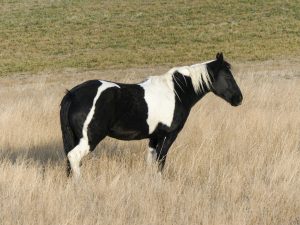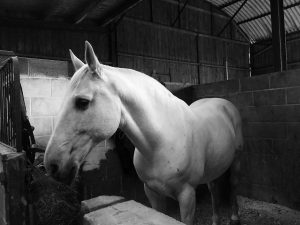
Broken horses, Broken people – how they can save each other (northern New Mexico, March 2013 – September 2014; 1990s flashbacks): The historic relationship between horses and people goes back centuries. Yet it’s only been since the 1950s that a therapeutic bond – Equine Therapy – has been seriously applied to physical and mental health rehabilitation and healing.
In Ginger Gaffney’s remarkable memoir, the “horse-human” relationship goes much further psychologically. It’s a “last shot” lifeline for a select group of prisoners on a “livestock team” at an “prison-alternative” 17-acre ranch north of Santa Fe, New Mexico. Horse therapy in this “river valley dealing with the blight of poverty and drug addiction much longer than the rest of the states” offers a “sliver of hope” for some convicts stuck in a pernicious cycle in and out of prisons.
Half Broke is a beautiful read, with an empowering message of inspiration and hope that some castaways can find a way out from their inner demons, as impossible as that may seem. Making the memoir a call to prison activists urging reform of our broken criminal justice system.
The author has changed the names of the people in this story out of respect for their privacy. It’s likely, though, she hasn’t for the “giant gods” – “traumatized” wild horses so mistreated and misunderstood they terrorize, having become “dangerous” creatures no one could touch. When they do, horses and people get hurt.
That’s what inspired the prison ranch story. In March 2013, Gaffney received a frantic call from the DS Ranch that one of their wild horses, Luna, was beaten so badly she could lose her eyesight. The caller, Sarah, and Luna, are part of the ranch’s innovative horse-people “gentling” program.
This is no ordinary Western ranch. It’s managers, the “elders,” unconventional ranch owners (no authorities, only prisoners). Residents are not typical ranch hands. Nothing ordinary is happening in these pages. And, candidly, Gaffney tells us she’s not ordinary either, profoundly connecting this enormously talented horse-trainer with 25 years experience to dysfunctional souls and wild horses.
Horses feel “every little touch.” You too will feel the sensitive and perceptive touch of the author’s toolbox of skills to gentle horses and people society has given up on.
Miracles can happen, but not for all. When things go wrong – and plenty does – the prose rises to a suspenseful rhythm and pace, evoking the edge at which “recovery can be slipped away.” Including the author’s.
This searing tale has everything to do with trust, starting with Gaffney who deeply trusts the power of horses to save people. When a significant breach occurs, it shatters Gaffney’s trust in the team. She’s fragile, just like them. Occasional flashbacks to the author’s childhood and coming-of-age years enlightens.
For the first six years of Gaffney’s life, she barely spoke a word. “Extreme shyness” shaped enduring feelings of loneliness and isolation. An unintended benefit of those silent years resulted in Gaffney becoming a keen observer of people’s non-verbal body language and movements, enabling her to quickly assess visual clues as to the emotions these behaviors are communicating. Relating to them personally, she doesn’t act condescending towards the prisoners. She treats them as equals, expecting a lot. She does so for 1½ years, never getting paid. Money isn’t her objective. This becomes her mission, her calling. In turn, everyone is respectful to and grateful for Gaffney’s perseverance at a place “she’s never seen anything like.”
Gaffney’s personal story starts first with sizing up people, then horses. A pro at understanding what the “complex communication systems” of horses are telling us.
Most of the novel is structured in 2013/2014 ranch chapters, a month a time. A step-by-step approach similar to the mantra of taking things one day at a time. Except here it’s literally, gravely, “one step at a time.” One measured, mentored step at a time.
“Fascination with horses came from a place inside me I have never understood,” says the author. We see how this plays out in those few flashback-to-the-90s chapters; few because this memoir isn’t meant to be about her, though she’s at the center of it. We do, though, learn some key things about the author’s emotions: she’s an extremely private person, who didn’t feel she belonged anywhere until horses came into her life. “We all come from somewhere, but that doesn’t mean we belong.” The honesty of horses is what she profoundly cherishes, trusting these majestic animals far more than people. We see how much that matters when the author’s first horse, Belle, rescues her.
At the ranch Gaffney feels she belongs. Eventually, she feels most at home there. While she has a supportive partner, Glenda, she describes her sexuality as another reason she’s felt like an outsider. Not at the ranch, where everyone is an outsider.
For someone whose been quite uncomfortable around people, with a horse Gaffney shows an exceptional touch with those in a “sunken place.” She gets their “broken parts” – “their lack of attention span, their wounded bodies, their anger, the dullness in their eyes” – saying they “look like me.” Or, how she used to look, be.
Her human team consists, over time, of three of about 10 women at the ranch: Flor, Sarah, Eliza. Of the 90 or so men, there’s Tony, Randy, Marcus, Rex, Paul, Omar. The horse team includes sisters Luna and Estrella, Hawk, Billy, Moo, Joker, Izzy, Willie. They represent a number of breeds, such as Painted Horse, Morgan Gelding, Lusitano.

via Pixabay

by Countercanter [CC BY-SA]

via Pixabay
All the people/horse names means there’s a lot of characters with individual traits. Horses loom large. A breathtaking challenge for this horse-trainer/psychologist who must keep track of all, to protect, and earn and keep the fragile trust.
Trust is fundamental. Not easy for prisoners lacking role-models, who’ve been let down over and over; people who then let themselves down to a point of feeling there’s no return.
Trust is not easy for Ginger Gaffney either, who “learned to hide, to become invisible.” But now she must be visible. More so, as she has to put herself out there, in harm’s way. Once she evaluates and treats Luna’s emergency, and assesses the team, she leaps in:
“If you want these horses to respect you, you’ll have to respect yourself … How you walk, how you hold your posture, this will tell the horses whether to stomp you or follow you. It also tells them if you are trustworthy or fake.”
There’s more going on at this ranch than horse-training: vocational skills training to fix cars and other mechanical objects, plumbing, ceramics, cooking. Life skills for earning a living when prisoners complete their sentences and are ready to venture out.
Should you Google the DS Ranch, you’ll come up empty. The author has obscured the ranch’s name too, presumably to protect its space. If you keep at it, you may make an eye-opening discovery that this unusual ranch exists elsewhere around the country; and that there are other alternative prison programs managed by the Bureau of Land Management (BLM) conceived as an approach for handling some of the heart-tugging controversy over what to do, if anything, about mustangs running wild on Federal lands in the West.
“I’ve always felt that riding horses was like riding a wave. The wave rolls you along. You don’t kick the wave, or beat it, or even think you can control it. Every wave is unique,” says the author. Though horse therapy programs are fanned out across the country, the people and horses in this vivid, stunning memoir are unique.
Lorraine